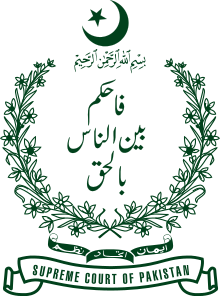S. A. Rahman
| Sheikh Abdur Rehman شیخ عبد الرحمان | |
|---|---|
| Chief Justice of Pakistan | |
|
In office 1 March 1968 – 3 June 1968 | |
| Appointed by | Ayub Khan |
| Preceded by | Alvin Robert Cornelius |
| Succeeded by | Fazal Akbar |
| Personal details | |
| Born | 4 June 1903 |
| Died | 25 July 1990 (aged 87) |
| Alma mater |
University of the Punjab University of Oxford Cairo University |
Dr. Sheikh Abdur Rehman (Urdu, شیخ عبد الرحمان) (June 4, 1903 – July 25, 1990) was a Chief Justice of Pakistan. He did his MA from University of Punjab, BA Hons from Oxford and Ph.D. in Law from Cairo.
Abdur-Rehman entered Indian Civil Services in 1926. He served in the capacity of Assistant Commissioner and District and Sessions Judge in various Districts of Punjab. He was appointed as Judge Lahore High Court in 1946.
In 1947, he was appointed as the Member of Bengal Boundary Commission. From 1947-52 he acted as the Custodian of Evacuee Property Punjab. Abdur-Rehman remained the vice-chancellor of Punjab University Lahore from 1950 to 1952. He became the Chief Justice of Lahore High Court in 1954. He was elevated as the Chief Justice West Pakistan High Court in 1955. In 1958 he was made the Judge, Supreme Court of Pakistan. He replaced Justice A.R. Cornelius as the Chief Justice of Supreme Court of Pakistan. He retired as the Chief Justice on June 3, 1968. He also acted as Chief Election Commissioner in 1964, 1965, 1966, and 1967.
Besides his Professional career he remained the Chairman Central Urdu Board Lahore, Director Institute of Islamic Culture, Lahore, Member Bazm-i-Iqal and the Board for the Advancement of Literature and President Pakistan Arts Council.
Abdur-Rehman has also three books to his credit; TARJUMAN-I-ISRAR (Urdu translation in verse of Iqbal's ISRAR-I-KHUDI, SAFAR a collection of Urdu poems, and Punishment Of Apostasy In Islam.
Abdur-Rehman had several sons.
See also
| Legal offices | ||
|---|---|---|
| Preceded by Alvin Robert Cornelius |
Chief Justice of Pakistan 1968 |
Succeeded by Fazal Akbar |
